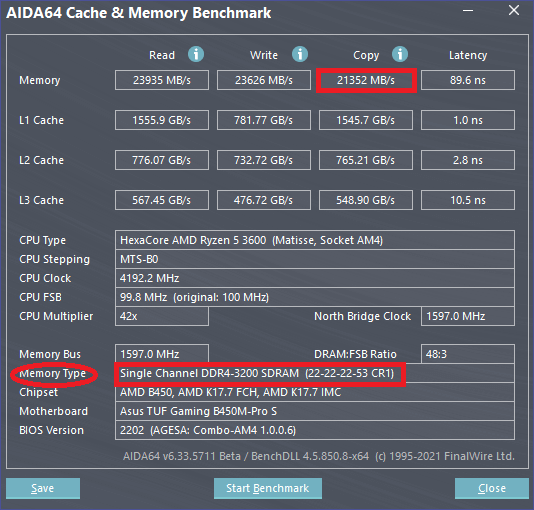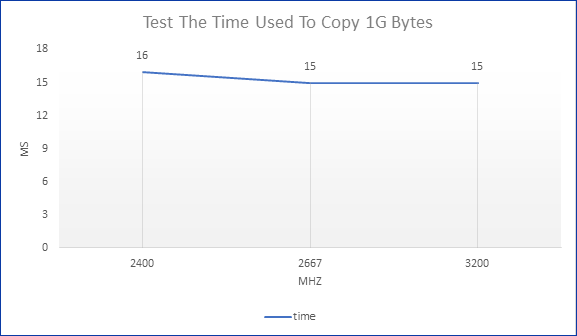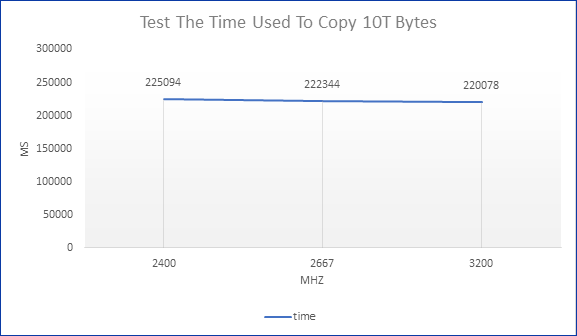DDR4 2400, 2667 & 3200 Speed Test, Who is The Best Choice?

A new generation of memory is developed to improve the speed of the previous generation of memory. As the mainstream of memory, DDR4 will gradually replace others. When it comes to selecting DDR4, lots of people are hesitant about which frequency to choose. Therefore, this article will test the copy speed of DDR4 with different frequencies, such as DDR4 2400, DDR4 2667 and DDR4 3200, through following two methods.
Basic Computer Configuration |
|||
|---|---|---|---|
CPU |
AMD Ryzen 5 3600 6-Core Processor |
Motherboard |
Asus TUF Gaming B450M-Pro S |
Graphics Card |
NVIDIA GeForce GT 610 |
Disk Drive |
TOSHIBA HDWD110 (1T, 7200 RPM, SATA-III) |
RAM |
8 GB DDR4 SDRAM |
RAM Frequency |
2400MHz,2667MHz,3200MHz |
Way 1: Test the speed by using special testing software
There are a number of ram speed test softwares to use. I choose AIDA64 Extreme to test memory benchmark. Let’s see the results I have tested.
The first is the result of DDR4 2400 and its copy speed is only 16666 MB/s.

The second is the result of DDR4 2667 and its copy speed is 18040 MB/s, which is a little faster than that of DDR4 2400.

The last is the result of DDR4 3200 and its copy speed can reach 21352 MB/s, which is a little faster than that of DDR4 2667.

Tips: As you can see from the pictures above, the DDR4 I use is single channel, whose speed cannot reach as fast as the dual channel. Under normal conditions, the speed of dual channel can reach twice that of single channel.
Let’s make a chart to see it more intuitively:

According to the graphs above, we can draw a conclusion that as the frequency of DDR4 increases, its speed also increases but not significantly. DDR4 generally operates at 2133 MHz, and can reach 3200 MHz with the new circuit architecture. If the memory of the same generation has the same capacity and their frequencies are not much different, the speed of DDR4 with high frequency is slightly higher than that with low frequency. So, among DDR4 2400, DDR4 2667 and DDR4 3200, the performance of DDR4 3200 is a little better.
Way 2: Test the speed by writing code and calculating the result
Another way is to write some codes to test the time used to copy some bytes. For instance, we can test how much time it takes to copy 1G bytes and 10T bytes. Testing different sizes of bytes is more helpful to judge the difference of DDR4 with different frequencies. Here is the code:
// Memory copy performance test#include<windows.h>
#include<string.h>
#include<iostream>
int main()
{
int i = 0;
char* pbuf1 = new char[1024 * 1024]; // Allocate 1MB buffer
char* pbuf2 = new char[1024 * 1024]; // Allocate another 1MB buffer
memset(pbuf1, 0, 1024 * 1024);
memset(pbuf2, 1, 1024 * 1024);
int ibegin = GetTickCount();
int iend = 0;
while (i < 1000) /* Performance test loop */
{
i++;
memcpy(pbuf1, pbuf2, 1024 * 1024); // The key operation being measured
}
int itime = GetTickCount() - ibegin;
printf("time used:%d \n", itime);
return 0;
}
These two are the time of DDR4 2400 used to copy 1G bytes and 10T bytes respectively. It takes 16 MS to copy 1G bytes and 225094 MS to copy 10T bytes.


These two are the time of DDR4 2667 used to copy 1G bytes and 10T bytes respectively. It takes 15 MS to copy 1G bytes and 222344 MS to copy 10T bytes.


The last two are the time of DDR4 3200 used to copy 1G bytes and 10T bytes respectively. It takes 15 MS to copy 1G bytes and 220078MS to copy 10T bytes.


Let’s also make two charts to observe them respectively:


It's obvious that if we use DDR4 to copy 1G bytes, the time is almost the same. Even if we use DDR4 to copy 10 T bytes, the time gap is also not very big. What's more, in most cases, we usually copy 1G or less bytes of data. It's very rare to copy 10T or more bytes.
Closing thoughts
Although the performance of DDR4 3200 is a little better, it is similar to the other two memories and its price is high. I don’t recommend this because it is not cost-effective. In the actual experience, if not necessary,DDR4 2333orDDR4 2667is enough. After all, you ought to pay attention to not only frequency but also the capacity which is another factor that affects performance. So, don't need to pursue DDR with high frequency unless you would like to spend much money on it.




















